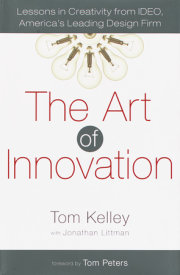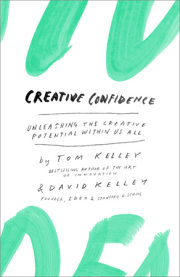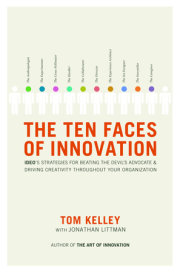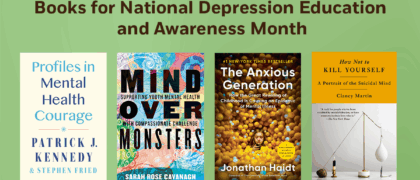1 -- Innovation at the Top
Innovation wasn't always a hot topic in the Silicon Valley. More than a decade ago, when our firm was just a small group of product designers working over a dress shop in Palo Alto, we became very interested in why companies looked outside for product development. We hired a professional services firm to help answer that question, and after interviewing many clients (and nonclients) we distilled the answers down into four key reasons: One was just raw
capacity. Companies had a bigger appetite than their in-house resources could satisfy. The second was
speed. If they couldn't find anybody in-house to sign up to some incredibly tight deadline, they would look outside. The third reason was the need for some specific
expertise outside their core competencies. And the fourth was
innovation.Well, a funny thing has happened in the ensuing years. Innovation has risen from the bottom to the top of the list. During that time, IDEO has broadened its client base to include some of the best-known and best-managed companies in the world. I personally have met with executives from more than a thousand companies to talk about their organizations' emerging technologies, market perceptions, and, of course, product development plans. With more than a thousand firsthand experiences, it's hard
not to spot emerging trends unless you are truly asleep at the wheel. The biggest single trend we've observed is the growing acknowledgment of innovation as a centerpiece of corporate strategies and initiatives. What's more, we've noticed that the more senior the executives, the more likely they are to frame their companies' needs in the context of innovation.
To those few companies sitting on the innovation fence, business writer Gary Hamel has a dire prediction: "Out there in some garage is an entrepreneur who's forging a bullet with your company's name on it. You've got one option now?to shoot first. You've got to out-innovate the innovators."
Today companies seem to have an almost insatiable thirst for knowledge, expertise, methodologies, and work practices around innovation. The purpose of this book is to help satisfy some of that thirst, drawing on IDEO's experience from the "front lines" of more than three thousand new product development programs. Our experience is direct and immediate, earned from practical application, not management theory. We've helped old-line Fortune 500 companies reinvent their organizations and bold young start-ups create new industries. We've helped design some of the world's most successful products, everything from the original Apple mouse, once called "the most lovable icon of the computer age." to the elegant Palm V handheld organizer. Whether you are a senior executive, a product manager, an R&D team leader, or a business unit manager, we believe this book can help you innovate.
One of the advantages of our front-lines experience is that we've collected a wealth of contemporary success stories from leading companies around the world. We've linked those organizational achievements to specific methodologies and tools you can use to build innovation into your own organization. I think you'll find that this book will help you to arrive at insights that are directly relevant to you and your company.
I joined IDEO in the late 1980s, when it was reaching that critical stage at which many start-ups either stall or implode. Since that time, however, IDEO has grown dramatically in size and influence, and
Fast Company magazine now calls it "the world's most celebrated design firm." The
Wall Street Journal dubbed our offices "Imagination's Playground," and
Fortune titled its visit to IDEO "A Day at Innovation U." Every spring,
Business Week publishes a feature story on the power of design in business and includes a cumulative tally of firms who have won the most Industrial Design Excellence Awards. IDEO has topped that list for ten years running.
What's unique about IDEO is that we straddle both sides of the innovation business, as both practitioners and advisers. Every day we work with the world's premier companies to bring innovative products and services to market. Even the best management consulting firms don't enjoy that hands-on, in-the-trenches experience. Yet, like the best consulting firms, we sometimes host teams from multinational companies who want to learn from our culture and steep themselves in our methodology. In other words, we don't just
teach the process of innovation. We actually
do it, day in and day out.
As I was completing this book, Tiger Woods was winning the U.S. Open golf tournament at Pebble Beach, dominating the field as never before. He seemed both intense and utterly calm. His dedication was complete, and his swing and putting were nearly perfect. In spite of what looked like masterful putting in his first round, he insisted that the balls weren't going into the hole smoothly enough for him. They were just "scooting," he said, not rolling. He stayed on the practice green till they rolled beautifully. Butch Harmon, his swing guru, said Tiger was playing better than ever. "He's confident. He's mature," said Harmon. "We've built his swing together, so it's pretty easy to tweak if something goes wrong." I found that a wonderful, enlightening statement. The greatest golfer in history, who appears to be the ultimate solo performer, is actually the product of a
team effort, and when the occasional bumps in the road arrive, the going is easier because of that fact.
Our approach to innovation is part golf swing, part secret recipe. There are specific elements we believe will help you and your company to be more innovative. But it's not a matter of simply following directions. Our "secret formula" is actually not very formulaic. It's a blend of methodologies, work practices, culture, and infrastructure. Methodology alone is not enough. For example, as you'll see in chapter 6, prototyping is both a step in the innovation process and a philosophy about moving continuously forward, even when some variables are still undefined. And brainstorming (covered in chapter 4) is not just a valuable creative tool at the fuzzy front end of projects. It's also a pervasive cultural influence for making sure that individuals don't waste too much energy spinning their wheels on a tough problem when the collective wisdom of the team can get them "unstuck" in less than an hour. Success depends on both
what you do and
how you do it.
The Innovation Decathlon
Here's the good news. Neither you nor your company needs to be best of class in every category. Like an Olympic decathlon, the object is to achieve true excellence in a few areas, and strength in many. If you're the best in the world at uncovering your customers' latent, unspoken needs, the strength of your insights might help you succeed in spite of shortcomings elsewhere. Similarly, if you can paint a compelling visualization of the future, maybe your partners (suppliers, distributors, consultants, etc.) or even your customers can help you get there. If there are ten events in creating and sustaining an innovative culture, what counts is your total score, your ability to regularly best the competition in the full range of daily tests that every company faces.
A Method to Our Madness
Because of the eclectic appearance of our office space and the frenetic, sometimes boisterous work and play in process, some people come away from their first visit to our offices with the impression that IDEO is totally chaotic. In fact, we have a well-developed and continuously refined methodology; it's just that we interpret that methodology very differently according to the nature of the task at hand. Loosely described, that methodology has five basic steps:
1. Understand the market, the client, the technology, and the perceived constraints on the problem. Later in a project, we often challenge those constraints, but it's important to understand current perceptions.
2. Observe real people in real-life situations to find out what makes them tick: what confuses them, what they like, what they hate, where they have latent needs not addressed by current products and services. (More about this step in chapter 3.)
3. Visualize new-to-the-world concepts and the customers who will use them. Some people think of this step as predicting the future, and it is probably the most brainstorming-intensive phase of the process. Quite often, the visualization takes the form of a computer-based rendering or simulation, though IDEO also builds thousands of physical models and prototypes every year. For new product categories we sometimes visualize the customer experience by using composite characters and storyboard-illustrated scenarios. In some cases, we even make a video that portrays life with the future product before it really exists.
4. Evaluate and refine the prototypes in a series of quick iterations. We try not to get too attached to the first few prototypes, because we know they'll change. No idea is so good that it can't be improved upon, and we plan on a
series of improvements. We get input from our internal team, from the client team, from knowledgeable people not directly involved with the project, and from people who make up the target market. We watch for what works and what doesn't, what confuses people, what they seem to like, and we incrementally improve the product in the next round.
5. Implement the new concept for commercialization. This phase is often the longest and most technically challenging in the development process, but I believe that IDEO's ability to successfully implement lends credibility to all the creative work that goes before.
We've demonstrated that this deceptively simple methodology works for everything from creating simple children's toys to launching e-commerce businesses. It's a process that has helped create products that have already saved scores of lives, from portable defibrillators and better insulin-delivery systems to devices that help grow sheets of new skin for burn victims.
Copyright © 2001 by Tom Kelley. All rights reserved. No part of this excerpt may be reproduced or reprinted without permission in writing from the publisher.












